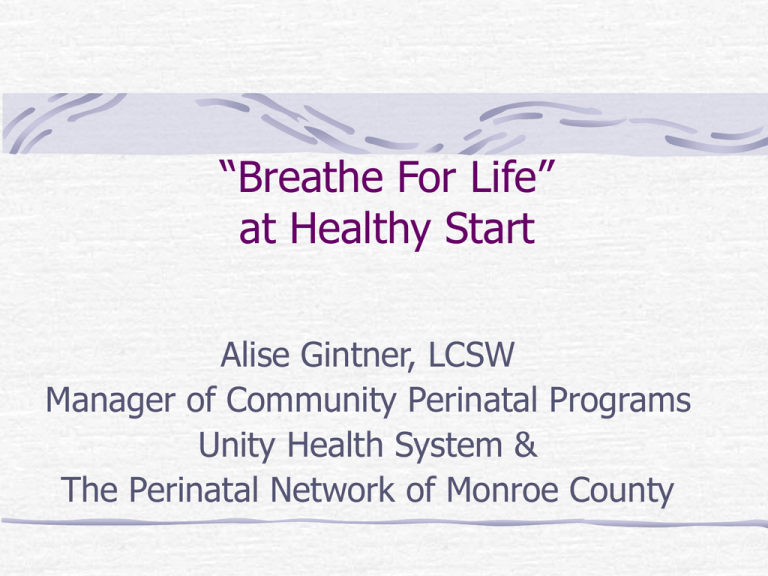Breathe for Life- Smoking Cessation Through Stress Management
advertisement

“Breathe For Life” at Healthy Start Alise Gintner, LCSW Manager of Community Perinatal Programs Unity Health System & The Perinatal Network of Monroe County What is Breathe For Life? A perinatal quit smoking and relapse prevention program that focuses on smoking cessation services combined with relaxation techniques and stress reduction interventions. Smoking & Pregnancy The U.S. Surgeon General has reported that eliminating smoking during pregnancy could prevent 10 percent of all infant deaths due to perinatal conditions. Theoretical Frameworks of Breathe For Life • Dr. Herbert Benson’s “Relaxation Response”. • The “5 A’s”. • The Stages of Change The Fight or Flight Response • • • • Anxiety and tension can trigger the fight or flight response which releases adrenaline, epinephrine and norepinephrine into the body causing: Increased heart rate Increased breathing rate Increased blood pressure Increased metabolic rate Stressful Life Events and Physiological Changes When we are faced with situations that require adjustment of our behavior (like quitting smoking) the fight or flight response is triggered. The “Relaxation Response” • • • • When the mind is focused, whether through meditation or other repetitive mental activities, the body responds with a dramatic: Decrease in heart rate Decrease in breathing rate Decrease in blood pressure Decrease in metabolic rate Coping with Stress The fight or flight response can be balanced with the relaxation response. In other words: Mind-focusing relaxation techniques can be used to decrease the impact of stressful life experiences. Mind-Focusing Relaxation Techniques Deep Breathing Mind-Focusing Relaxation Techniques Meditation Mind-Focusing Relaxation Techniques Progressive Muscle Relaxation Mind-Focusing Relaxation Techniques Guided Imagery Mind-Focusing Relaxation Techniques Yoga Mind-Focusing Relaxation Techniques Sand Mandalas The 5 A’s • An evidence-based clinical approach to helping pregnant women quit smoking. • Consists of a 5 to 15 minute counseling session. • Includes providing the patient/client with pregnancy specific quit-smoking help materials. The 5 A’s ASK about smoking behavior ADVISE about the risks of smoking ASSESS her willingness to quit ASSIST her with ways to quit by teaching skills and providing support • ARRANGE follow-up appointments to provide ongoing support or a referral for more intensive services if needed. • • • • The Stages of Change Model Behavior change is rarely a discrete, single event. Most individuals move gradually from being uninterested in change, to considering a change, to deciding and preparing to make a change. The Stages of Change Model • Precontemplation Stage • Contemplation Stage • Preparation Stage • Action Stage • Maintenance Precontemplation Stage The individual does not even consider changing. Smokers who are “in denial” may not see that the advice applies to them personally or is helpful. Contemplation Stage The individual is ambivalent about changing. Giving up an enjoyed behavior causes them a sense of loss despite the perceived gain. During this stage, individuals assess barriers (time, expense, hassle, fear, “I know I need to, but..”) as well as the benefits of change. Preparation Stage The individual prepares to make a specific change. They may experiment with small changes as their determination to change increases. Switching to a different brand of cigarettes signals that they have decided a change is needed. Action Stage The individual takes action to change their behavior. Any positive action should be praised as it demonstrates the desire for lifestyle change. Maintenance Involves incorporating the new behavior (the behavior change) over the long haul. Many individuals find themselves “recycling” through the stages of change several times before the change becomes truly established. Relaxation & The Stages of Change The individual must internalize relaxation coping skill to improve success rate with quitting smoking. 2008 Breathe For Life Results Sample size = 52 •63% quit smoking •34% decrease number of cigarettes smoked by more than half. •3% no change. Guided Imagery Exercise








